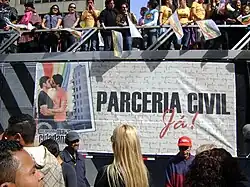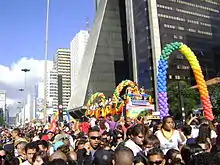São Paulo Gay Pride Parade
São Paulo LGBTQ Pride Parade (Portuguese: Parada do Orgulho LGBTQ de São Paulo) is an annual gay pride parade that has taken place in Avenida Paulista, in the city of São Paulo, Brazil, since 1997. It is South America’s largest Pride parade,[lower-alpha 1] and is listed by Guinness World Records as the biggest pride parade in the world starting in 2006 with 2.5 million people.[6] They broke the Guinness record in 2009 with four million attendees.[12] They have kept the title from 2006 to at least 2016.[13] They had five million attendants in 2017.[10] As of 2019 it has three to five million attendants each year.[14] In 2019, it was also the second larger event of the city of São Paulo in terms of total revenue (after Carnaval) and the first in terms of daily revenue.[15] In 2010, the city hall of São Paulo invested 1 million reais in the parade.[16] According to the LGBT app Grindr, the gay parade of the city was elected the best in the world.[17]
| São Paulo Gay Pride Parade | |
|---|---|
.jpg.webp) São Paulo LGBT Pride Parade of 2014 | |
| Date(s) | Sunday after the annual holiday of Corpus Christi |
| Frequency | Annually |
| Location(s) | São Paulo, Brazil |
| Inaugurated | June 1997 |
| Most recent | 11 June 2023 |
| Participants | Over 5 million (2013) |
The Pride and its associated events are organized by the APOGLBT (Associação da Parada do Orgulho de Gays, Lesbicas, Bissexuais e Travestis e Transexuais), since its foundation in 1999. The march is the event's main activity and the one that draws the biggest attention to the press, the Brazilian authorities as well as to the hundreds of thousands of curious people that line themselves along the parade's route. In 2009, 3.2 million people attended the 13th annual São Paulo Gay Pride Parade.
The meeting point is at the Museum of Art of São Paulo (MASP – Museu de Arte de São Paulo) right at the middle of São Paulo's postcard Avenida Paulista. Even though the meeting time is at 12 noon, the parade doesn't start to move before 2 or 3 PM. The parade is 2.6 miles long (4.2 km) and starts at Avenida Paulista (MASP), at around noon. It follows Rua da Consolação to the end at Praça Roosevelt, in Downtown São Paulo, at around 10 PM.
The São Paulo Gay Pride Parade is heavily supported by the federal government as well as by the Governor of São Paulo and the city mayor. Many politicians show up to open the main event and the government often parades with a float with politicians on top of it. Caixa Econômica Federal, a government bank, and Petrobrás, Brazil's oil firm, have already reaffirmed their commitment to back up the event and its diversity, funding once again the event. In the Pride the city usually receives about 400,000 tourists and moves between R$ 180 million and R$ 190 million.[18] Because of this support, the event has many security measures in place. Since the election of Jair Bolsonaro as president of Brazil in 2018, there has been concern that the federal government would withdraw support for the parade, given Bolsonaro's previous anti-LGBTQ sentiments.[19]
Due to the COVID-19 pandemic, the parade was celebrated virtually in June 2020. The in-person parade was initially postponed until November 29, 2020, but was ultimately cancelled entirely.[20]
Participants

The first parade in 1997 gathered around 2,000 participants, according to the military police.[21] The ninth parade gathered over 2.5 million people according to the police and 3 million according to the organizers.
The military police, which traditionally counts the number of participants at major public events, does not release its estimates for attendance at the parade since then, which caused the omission of the Parade from the 2008 issue of Guinness that requires official sources for records regarding attendance at events. According to the police, it would be impossible to count the number of people attending an event with a "floating population." There has been controversy about the exact number of participants.
| Year | Participants | |
|---|---|---|
| Organizers | Military Police | |
| 1997 | 2,000 | 2,000 |
| 1998 | 8,000 | 8,000 |
| 1999 | 35,000 | 35,000 |
| 2000 | 120,000 | 100,000 |
| 2001 | 250,000 | 200,000 |
| 2002 | 500,000 | 400,000 |
| 2003 | 1,000,000 | 800,000 |
| 2004 | 1,800,000 | 1,500,000 |
| 2005 | 2,500,000 | 1,800,000 |
| 2006 | 3,000,000 | 2,500,000 |
| 2007 | 3,500,000 | – |
| 2008 | 3,400,000 | – |
| 2009 | 3,100,000 | – |
| 2010 | 3,300,000 | – |
| 2011 | 4,100,000 | – |
| 2012 | 4,200,000 | 270,000 |
| 2013 | 5,000,000 | 220,000 |
| 2019 | 3,000,000[9] | |
Slogans

- 1997 – "We are many, we are in every occupation"
- 1998 – "The rights of gays, lesbians and travestis are human rights"
- 1999 – "Gay pride in Brazil, on the way of the year 2000"
- 2000 – "Celebrating the pride of living diversity"
- 2001 – "Embracing diversity"
- 2002 – "Educating for diversity"
- 2003 – "Building homosexual policies"
- 2004 – "We have family and pride"
- 2005 – "Civil partnership now. Equal rights! Neither more nor less"
- 2006 – "Homophobia is a crime! Sexual rights are human rights"
- 2007 – "For a world without racism, macho sexism and homophobia"
- 2008 – "Homophobia kills! For a secular state de facto"
- 2009 – "No homophobia, more citizenship – For the isonomy of rights!"
- 2010 – "Vote against homophobia, defend citizenship" (*2010 is election year in Brazil)
- 2011 – "Love one Another. Enough with homophobia"
- 2012 – "Homophobia has a cure: Education and criminalization"
- 2013 – "Back to the closet, never again! Union and awareness in the fight against homophobia"
- 2014 – "A successful country is a country without homophobia. No more deaths! Criminalization now! "
- 2015 – "I was born like this, I grew up like this, I will always be like this: respect me!"
- 2016 – "Gender identity law, now! - All people together against transphobia!"
- 2017 – "Regardless of our beliefs, no religion is law! Together for a secular state!"
- 2018 – "Power to LGBTI+. Our Vote, Our Voice."
- 2019 – "50 Years of Stonewall - Our Achievements, Our Pride to be LGBT+."
- 2022 – "Vote With Pride."
- 2023 – "Social politics for LGBT+ - we want the whole and not the half"
See also
- List of LGBT events
- LGBT rights in Brazil
- Gay pride
- Gay pride parade
- Beyond Carnival by James N. Green
References
- As of June 2019, New York City’s NYC Pride March is North America’s biggest Pride parade. For Stonewall 50 – WorldPride NYC 2019 up to five million took part over the final weekend,[1][2][3] with an estimated four million in attendance at the parade.[4][5]
São Paulo, Brazil’s event, Parada do Orgulho GLBT de São Paulo, is South America’s largest, and is listed by Guinness World Records as the world’s largest Pride parade starting in 2006 with 2.5 million people.[6] They broke the Guinness record in 2009 with four million attendees.[7] They have kept the title from 2006 to at least 2016.[8] They had five million attend in 2017.[9][10] As of 2019 it has three to five million each year.[11] In 2019 they had three million.[9]
- Allen, Karma; Katersky, Aaron (July 2, 2019). "Millions more attended WorldPride than expected". ABC News. Retrieved 2019-07-09.
- Caspani, Maria; Lavietes, Matthew. "Millions celebrate LGBTQ pride in New York amid global fight for equality: organizers". Reuters. Retrieved 2019-07-08.
- Cannon, Sophie (2019-06-12). "New York City to unveil largest rainbow pride flag in city's history". New York Post. Retrieved 2019-07-08.
- O’Doherty, Cahir (July 4, 2019). "Irish march at historic World Pride in New York City". IrishCentral.com. Retrieved 2019-07-09.
- Lynch, Scott. "Photos: Massive Turnout For Euphoric NYC Pride March: Gothamist". Gothamist. Archived from the original on 2019-07-03. Retrieved 2019-07-09.
- Ripardo, SÉRGIO (May 28, 2008). "Guinness exclui recorde da Parada Gay - 28/05/2008". Folha Online. Retrieved 2019-07-09.
- Lawler, Opheli Garcia (June 18, 2017). "Brazil Holds World's Largest Pride Parade". The Fader. Retrieved 2019-07-09.
- Sheets, Cassie (June 1, 2017). "10 Things You Didn't Know About Pride". Pride.com. Retrieved 2019-07-09.
- Petrov, Arkady (2019-06-30). "2019 LGBT Parade in São Paulo Raised R$403 Million for the City". The Rio Times. Retrieved 2019-07-22.
- "Pride 2019: The world's 15 biggest LGBTQ celebrations, from New York to Tel Aviv". USA Today Travel. June 10, 2019. Retrieved 2019-07-08.
- Nomadic Boys (June 11, 2019). "South America's best Pride parades". Lonely Planet. Retrieved 2019-07-09.
- Lawler, Opheli Garcia (June 18, 2017). "Brazil Holds World's Largest Pride Parade". The Fader. Retrieved 2019-07-09.
- Sheets, Cassie (June 1, 2017). "10 Things You Didn't Know About Pride". Pride.com. Retrieved 2019-07-09.
- Nomadic Boys (June 11, 2019). "South America's best Pride parades". Lonely Planet. Retrieved 2019-07-09.
- "R$403 milhões: Parada LGBT ultrapassa F1 como evento mais lucrativo de São Paulo". Almanaque SOS (in Brazilian Portuguese). 2019-07-01. Retrieved 2021-06-09.
- Investments of the City Hall of São Paulo – LGBT Parade (in Portuguese)
- Grindr Awards For Gayest Cities, Beaches, And Marital Destinations (in English) Archived 2012-04-15 at the Wayback Machine
- Number of tourists and money during the LGBT Pride of São Paulo (in Portuguese)
- Reeves, Philip (June 23, 2019). "Brazilians Gather For Gay Pride Parade, Hoping To Send Message To Jair Bolsonaro". NPR. Retrieved 2021-03-29.
- Wenzel, Fernanda (July 24, 2020). "São Paulo postpones Carnival 2021 due to Covid-19 pandemic". CNN. Retrieved 2021-03-29.
- Marshall, Euan (June 12, 2017). "What To Know About the Sao Paulo Gay Parade, The World's Biggest LGBT parade". Retrieved 2021-03-29.
.svg.png.webp)